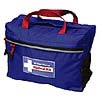Crew Safety Briefing

You can avoid many emergencies by conducting a proper safety briefing before leaving the dock. This also helps you to establish command and confidence in your crew.
Crew Briefing
The below briefing items are duplicated in PDF format for you to print out and leave on your vessel for a checklist briefing.
CABIN
Safety
- Oven and Stove use instructions
- Location of propane shut-off
- Fire
- Location of fire extinguishers
- Location of fire blankets
- Engine fire extinguisher port hole
- Battery isolation switch in case of electrical fire
- First aid kit location
- Grab (ditch) bags
- Thermal Protective aids – hypothermia
- Flares
- VHF Emergency Use
- No wet bodies inside the cabin – slippery floors are dangerous
- Stowage of personal items
General
- Expected weather conditions
- No sand inside the cabin
- House tidiness rules: wet clothing, towels, food, cooler, bathrooms
- Hygiene – Soap it up.
- Close hatches in the cabin when underway
- Close hatches in the salon when it rains at night
- Dealing with seasickness – take the helm – eat ginger.
- Shower pump switches
- Water pump switches
- Cabin light switches
- Head use – easy to block – keep clean – no skid marks
- Don’t pump out when others are swimming, in marinas, or national parks (if applicable)
- Fresh Water tank switch-over
- Water conservation. Tell the captain when switching over the tank.
- Position of the windlass reset switch.
- One person other than the skipper should be knowledgeable of:
- Cooker and gas
- Radio use for distress
- GPS use and navigation
ON DECK
Safety
- Extreme high tension on lines. Be careful when releasing. Wrap lines around the winch first before releasing
- Whipping of jib sheet as the boat is tacked
- Sailing downwind: Dangers of Gybe: – Walk on the boom side of the boat when going forward
- MOB
- Man overboard routine. Follow my lead
- MOB button on the chart plotter
- Captain overboard. Appoint able body
- MOB lift aboard
- Throwable lines and floatation device
- Life jacket location
- EPIRB
- Life Rings for MOB
- Life Raft
- Safety Harnesses
- Start and stop the engine and gears
General
- Procedures for fire, MOB, flooding
- Wind in fishing line when approaching an anchorage
- Bow-to-helm communication signals
- Pull dingy up to the boat when anchoring or mooring.
- Watch out for the dinghy painter before starting the engine
- Watch out for the dinghy painter before starting the engine (intentional repeat)
- Watch out for the dinghy painter before starting the engine (intentional repeat)
- Shorten dinghy painter when starting the engine, reversing, approaching a marina, anchoring or mooring
- Windlass use – let the boat do the work
- Watch elbows when starting the dinghy engine
DOCKING
Safety
- Step, don’t jump between the dock and the boat
- Stereo off
- Watch out for dock lines in the water before starting the engine
General
- Fender Clove Hitch and Fender placement
- Fending off the boat with roving fenders, not arms, legs, and hands
- The Cleat Hitch
- Follow my lead for dock line responsibility appointment
- Watch out for the dinghy painter before starting the engine and reversing







